Last Tuesday’s Question of the Week was, “Have you ever needed four-wheel drive while truck camping?” We had so many responses that we have split up the answers into two parts. To read Part 1, click here.
“For off the beaten path camp spots and getting on and off the road, I use four-wheel drive.” – Butch Bird, 2001 Dodge 3500, four-wheel drive truck, 2000 Lance 1010
“On three memorable occasions I’ve been very happy to have four-wheel drive. Living in the West, we have many national forests to choose from and, for each case, I was in need of four-wheel drive. First, while on a late deer season hunting trip with my father in the Tahoe National Forest, we were crawling along on a deeply rutted muddy forest service road. The ruts were so deep someone had cut a number of small logs and dropped them into the ruts. It gave us just enough clearance with the help of four-wheel drive to make it through. Second, my wife and I, our son, and our four-legged family member, Barkley, were in the Fremont National Forest in south eastern Oregon. We were over 8,000 feet in elevation looking to cross into California. We encountered snow drifts here and there. As we hit California, the nice Oregon red graveled road turned to muddy chuck holes. I decided to turn around.
Looking to my right, it was level and looked like hard packed dirt mixed with rock. I made the swing and almost immediately started losing traction in two-wheel drive. I opened the door and discovered I’d sunk almost to the running boards. I stopped and threw the truck into four-wheel drive and started to rock back and forth. We started to move and I just kept on the gas. We made it out, which sure was a good thing, because it would have been a long walk and I would have never heard the end of it. Third experience; again in Oregon. This time we were in the Siskiyou National Forest. We were traveling along side the Rogue River from Gold Beach on the coast fourteen miles east to a beautiful state run campground called Quosatana. A few miles along there’s a private run campground at the junction of the Rogue and Lobster Creek. We pulled in to take a look. We were told there was camping on the gravel bar so we drove on down. The gravel was somewhat soft so I shifted into four-wheel drive and we went through just fine, but we decided to go on to our old favorite Quosatana.
A few days later, when we crossed over the Lobster Creek bridge, we looked down and saw a head shaking sight. In that same gravel bar was a large motorhome sunk to the body. I sure wouldn’t have wanted his tow bill. It once again proves the saying; that a truck camper is the only true go anywhere, camp anywhere camping rig. For us it will always be four-wheel drive. There have been other needful times, but these were the most memorable. Sorry no photos, we were always more concerned about getting out.” – David Pracht, 1994 GMC K3500, four-wheel drive truck, 1987 Lance LC900
“We needed four-wheel drive in April of 2013 while camping in Monticello, Minnesota. I arrived at the campground to find ten inches of snow. I threw the truck into four-wheel drive and backed into my site on the banks of the Mississippi. There I enjoyed six weeks of heaven.” – Gary Smith, 2006 Ford F250, four-wheel drive truck, 2010 Palomino 8510
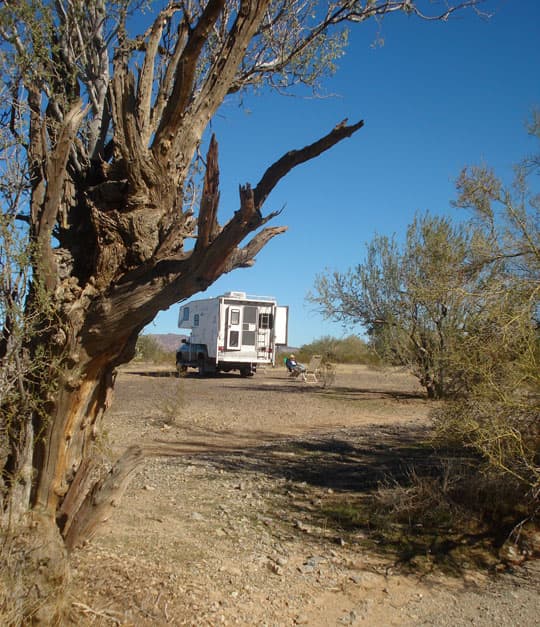
“Yes, I have used four-wheel drive in deep rutted sand out in the desert, deep snow on the highway, and on a slimy ramp when putting in the boat. All in all, I’m glad I’ve had it!” – David and Lila Weinstein, 1999 Dodge Ram 3500 Ram, four-wheel drive truck, Arctic Fox 1150
“I used our four-wheel drive to camp on the beach at Race Point, Cape Cod, Massachusetts and on the beach at Cape Hatteras, North Carolina. I use four-wheel drive low range to back under my camper. There is no need to touch the gas pedal at all. I also use it in New England snow storms without the camper.” – Gary Goyette, 2011 GMC 2500HD, four-wheel drive truck, 2011 Northern Lite 8-11
“I’ve been pulled by my dad twice to get to his property. When he built the house, he made the road better, and paved it. He’ll never let me live down that his Chevy had to pull out my Ford. There’s no problem now. I’ve had to be very careful at Glamis to not get stuck, and have avoided Pismo Beach (we ride quads) because I hear many get stuck there. I wish I had four-wheel drive for piece of mind. Even when four-wheel drive is not necessarily needed, the low gears in four-wheel drive low can be useful when pulling a tree stump or a large boat up the ramp.” – Ron Williams, 1997 Ford F250, two-wheel drive truck, 2003 Lance 1010
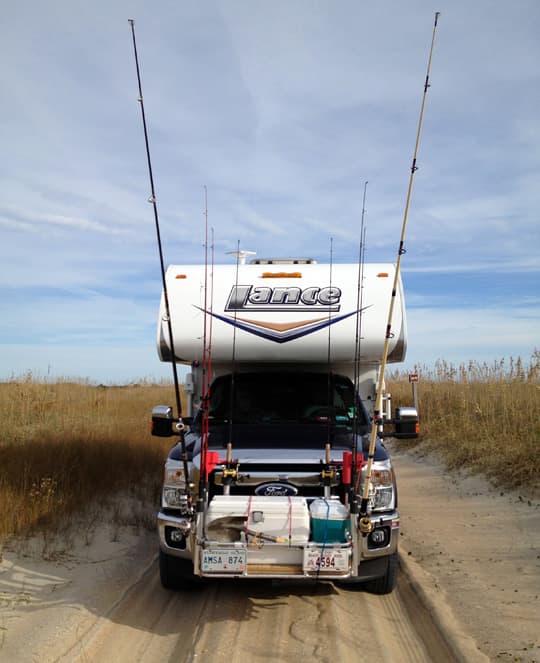
“We beach camp up and down the East Coast. The more remote the better. We are starting to think about our next truck and it will be a four-wheel drive truck and most likely a dually.” – Bob Gray, 2011 Ford F350, four-wheel drive truck, 2012 Lance 992
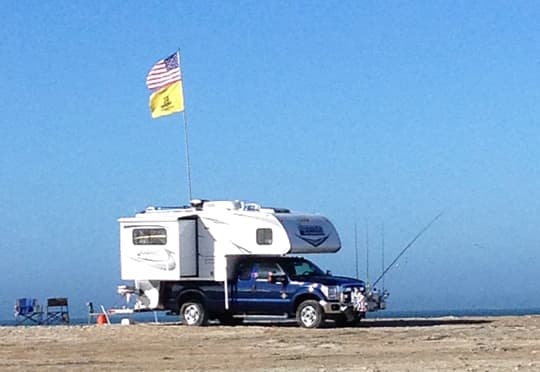
“The first time I used four-wheel drive I was in the Sand Hills of Nebraska and got stuck in the sand near a lake. I was able to dig behind the wheels and back out of the situation. The second time I was in the southeastern mountains of Arizona in January. I was going up the mountain when there was a dip in the road and then the road took a hard left. When I went around the corner I was suddenly confronted with snow on the road. It was too late to stop. I plowed forward and got stuck. It was a couple inches of snow on top of about four inches of ice slush.
I thought I was doomed on this lonely road where we saw no one in twelve miles. I dug out behind the wheels and then some folks came up behind me. They were a great help in guiding me back out of the snow pack. I think I would have made it through the snow if I had four-wheel drive.” – John Bull, 2004 Dodge 3500, two-wheel drive truck, Had a 2004 Lance 920, have Arctic Fox 990 on order
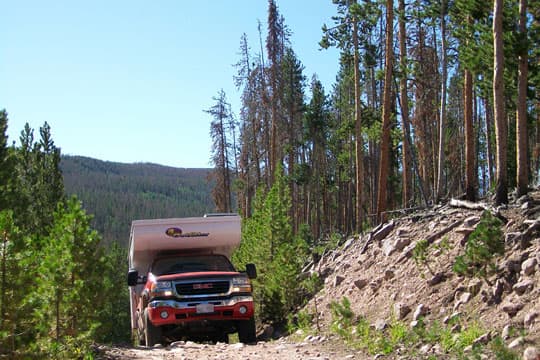
“We live in Utah, and travel mostly in the West and Southwest. We use our four-wheel drive in low range often, since we camp off-road a lot. Four-wheel drive is not only for slippery road conditions, but many times low range and high clearance are needed to crawl up, over, or down challenging road conditions (no matter where you travel), which means four-wheel drive is used.
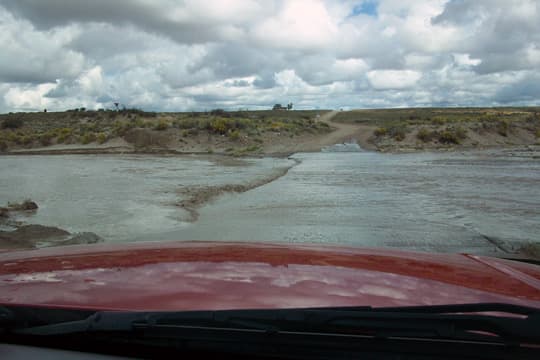
To buy a truck without four-wheel drive is short sighted, no matter where you live. The incremental cost to both purchase and operate a four-wheel drive truck is minimal compared to the total cost of truck camper ownership and operating costs. What four-wheel drive gives is capability, which immediately pays for itself the first time it is needed to get unstuck where you were not even aware you may have gotten stuck; even if it’s in a campground, shoulder of the road, etc.
Trucks with campers are heavy and large vehicles that are prone to getting stuck, where just the truck alone would not. Four-wheel drive is many times the get out of jail free card that no truck camper should be without.” – Terry Rey, 2007 GMC HD, four-wheel drive truck, 2011 Outfitter Apex 8
“It was our very first trip with our very first truck and camper. We were in Kasha-Katuwe Tent Rocks National Monument in New Mexico. At the end of the paved road was a sandy road with a wide pullout. It was perfect for turning around! I pulled in and stopped briefly to take a few pictures. When I started up again I couldn’t move forward or backward, despite several attempts. The rear tires were in about four inches of sand and going deeper.
Then we remembered we had four-wheel drive! I switched it into four-wheel drive and we were out of there in seconds. I’ll never get a truck without four-wheel drive. Even if you’re only stuck once, it’s worth it.” – Anne Marie Lewis, 2013 GMC 3500, four-wheel drive truck, 2013 Eagle Cap 850
“Colorado is full of hills. To get away from the throng of campers you need four-wheel drive and nerves of steel. A four-wheel drive pilot car is a big help as well. Just two to three hours from Denver is some of the best four-wheel drive trails for a fifth wheel in the nation.” – Bill P., 2013 Ford F350, four-wheel drive truck, 2007 Keystone Montana
“For me, it’s nice to have four-wheel drive about four or five times a year when a situation makes it convenient to have it. That said, I only have it because it came with the right truck. If there were identical trucks, one four-wheel drive and one not, I’d probably take the two-wheel drive.” – Al Hubbard, 2004 Silverado 2500HD, four-wheel drive truck, 2000 Starcraft Roadstar
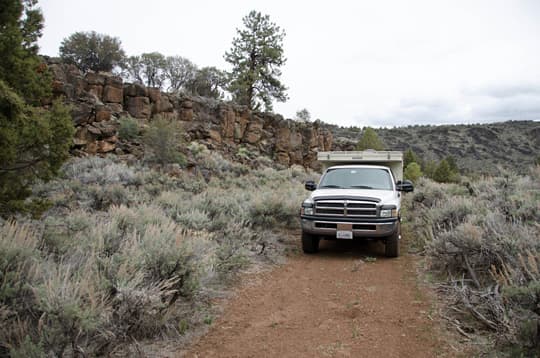
“Do I need it? No. Do I want it? Yes. The Dodge is my third four-wheel drive truck. Past trucks were an 1986 Ford F150 and 1979 Toyota. I would not have a truck without four-wheel drive.
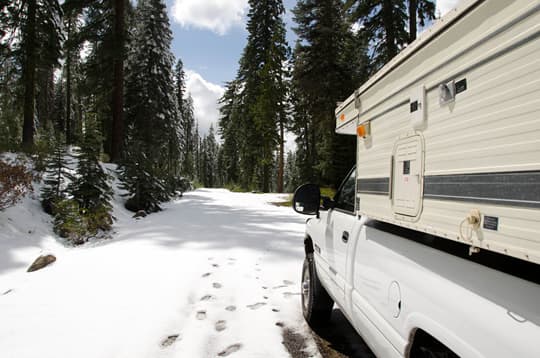
I enjoy exploring the back roads of northern California, Nevada, and eastern Oregon. Four-wheel drive has allowed me to continue on down the trail to a nice camping spot, fishing hole, or ghost town that I would otherwise not be able to make in two-wheel drive. I also find four-wheel drive helps where two-wheel drive would still make it, such as climbing a wash board hill.
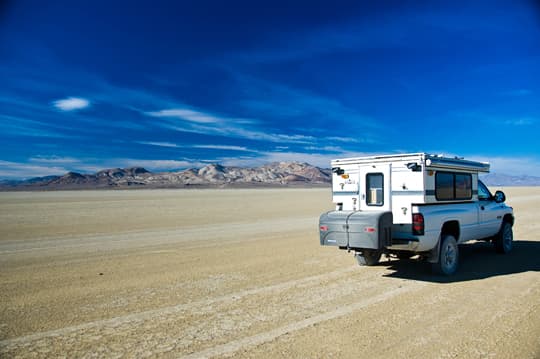
I can crawl up the hill in four-wheel drive eliminating any axle hop, making a much smother trip for gear and passengers.” – Bill Rose, 2002 Dodge Ram 2500, four-wheel drive truck, 1996 Four Wheel Grandby
“Yes I’ve needed it. I’ve been stuck in mud, sand, and on an icy boat ramp.” – Bill Beck, 2011 Ford F350, four-wheel drive truck, 2009 Host Everest
“Several times I’ve used four-wheel drive, but the first time was the most important. We tow a horse trailer and were camping with friends. One friend had a one ton dually and a gooseneck trailer. The site had a slope and the morning dew kept him from moving. He even slid backwards. I unhitched my trailer and towed him out using four-wheel drive low. I did not spin the tires at all.” – Don Norris, 2003 Chevy Silverado K2500HD, four-wheel drive truck, 2005 Travel Lite 800SBX
“Living in New Hampshire, I use four-wheel drive often. I also rely upon it in muddy situations. The low range comes in handy on steep hills when towing with the camper on board! I would not consider buying a truck without four-wheel drive.” – Allan Riley, 2004 Dodge 2500, four-wheel drive truck, 2008 Northstar 8.5 Arrow
“I would never buy a two-wheel drive truck. If I only need four-wheel drive one time to get me out of a remote snow packed or muddy campsite after bad weather, I would consider it well worth the extra expense and weight.” – Dale, 2007 Chevrolet 2500HD, four-wheel drive truck, 2012 Lance 992
“I would not buy a truck without four-wheel drive. I have camped along a river bank with a trail of mud and potholes and needed to get back out after a rain storm. I have also camped right out on the beach and forgotten high tide. I may not use four-wheel drive a lot, but I don’t want to walk forever for help.” – Randy, 2011 Ford F150, four-wheel drive truck, I’m still tent camping, I’ve got my heart set on a pop-up camper
“We bought the rig for a trip to Alaska in 2015 and intend to travel the whole state in a four to five month trip. That being said, we have traveled in bitter winter weather in snow that required four-wheel drive to make it through. We were also in snow and mud this spring that we almost didn’t make it through. We have a truck camper to travel the road less traveled. Don’t we all?” – Tom Elliott, 2012 Ram 1500, four-wheel drive truck, 2013 Outfitter 6.5 Lite
“I do not have four-wheel drive. Everyone I ever spoke to about four-wheel drive said they never use it. I did not want the extra maintenance or the extra weight. I have had my truck in snow and don’t take it places where it looks like I could get in trouble. My Grandfather used to tell me that if you need four-wheel drive you should not be there in the first place. I also like the daily fuel economy of 19 to 23 miles per gallon on the highway and the 15 to 16 in miles per gallon in town. So I will not ever have four-wheel drive on my truck.” – Patrick Seals, 2002 Dodge Ram 1500, two-wheel drive truck, Outfitter Caribou
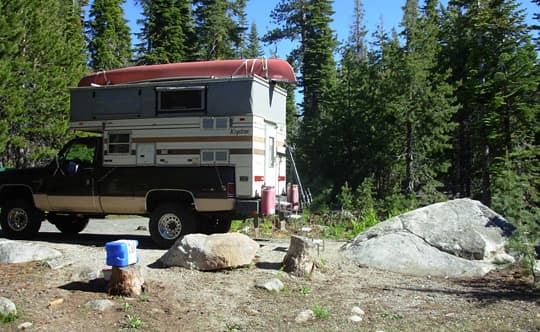
“I go camping five times a year, and used four-wheel drive on our last trip of the season since the road is very rough. I have also been in the backcountry on logging roads with one to two feet of snow and tire chains on the front during hunting season. My camper has been very reliable. The pop up is great for gas mileage.” – Mike Johnson, 1986 Chevy K30, four-wheel drive truck, 1987 Four Wheel Camper Keystone
“I pull a twenty-foot flatbed trailer with an off-road truck on it. I often use four-wheel drive low to maneuver the truck and trailer around, especially on hills, to reduce wear on the transmission. When my transmission failed going up the Grapevine, I was able to use four-wheel drive low to limp to the next exit and get off the highway where it was safe.
While I was camping in Ocotillo Wells, I had to use four-wheel drive to drive to our campsite and to drive up on my leveling blocks. Otherwise the rear tires would just dig in the soft silt/sand. I could have aired down, but then I would have to air back up, and that can take a while.” – Ivan, 1997 Ford F350, four-wheel drive truck, 1987 Western Wilderness Alpine 9’
“Most of our camping is on unpaved BLM and forest service roads in the West, so we often use four-wheel drive. Most of the time it’s four-wheel drive low range on steep down grades to keep my foot off the brake so the brakes won’t over heat.
One road that comes to mind was Kleinschmidt grade on the Idaho side of Hells Canyon. It was a white knuckle windy one lane road. One section drops 2,200 feet in 4.9 miles. Without low range to help slow us down, our brakes would overheat in no time.
Just two weeks ago we used four-wheel drive in the Eastern Oregon desert on a twelve percent grade into the Owhyee River canyon.” – Brian and Chris Hagen, 2000 Dodge Ram 1500, four-wheel drive truck, 2014 Palomino Backpack 1251
“I do not currently have a four-wheel drive truck for my camper rig, but I have two other four-wheel drive vehicles and many years of experience off-roading. I believe four-wheel drive could be very useful for certain truck camping situations, but there are some significant factors that anyone new to four-wheel drive trucks should consider before loading on a very large truck camper.
1. As mentioned, payload differences are often significantly different due to the weight and configuration of the four-wheel drive options.
2. A four-wheel drive truck is usually taller than its two wheel drive counterpart, even when loaded. That puts the rig center of gravity higher, and thus affects handling more than a two-wheel drive truck.
3. The typical off-road style aggressive tires are often not high load range tires, and may wear very quickly when carrying a truck camper. For highway driving with maximum payload, regular load range E tires are usually a better solution.
4. People who are experienced with four-wheel drive may be lulled into complacency by their unloaded experience and take a truck loaded with a camper into situations where it encounters what they would consider a minor amount of side slope. But, with a camper loaded, the truck’s center of gravity is now much higher than it was before, and a hill or rut that caused no problem unloaded could cause a tip over of the loaded truck.
5. Trying to go off-road with one of the larger campers and encountering dips or frame twist situations could result in damage to the truck or camper before you know it. In the case of my Bigfoot, the most likely source of damage would be the rear overhang which greatly changes the departure angle. It would be very easy to drag it on a transition or dip that, in unloaded form, you would never think twice about crossing.
6. Getting stuck in an off-road scenario could be much more interesting with an extra 4,000 pounds in the bed of the truck. Creative jacking and tow strap solutions could be required. The camper jacks themselves have been used successfully by some folks in these situations, but you have to have a strong camper.
7. Finally, the height of the rig can be a major impediment to off-roading. In forested areas some of the trails will not have clearance for 11+ foot tall rigs. On many four-wheel drive trails I have driven, it would be possible to get into spots where you could not go forward due to height obstruction, and could not turn around due to trail width. This could result in backing up a long way in the worst case scenario. For happy off-roading with a truck camper, the owner would probably be best off with a lighter and smaller rig that has minimal rear projection. One of the pop-up types is probably ideal. I would not hesitate to off-road with one and, in fact, my next truck camper will probably be a four-wheel drive truck with that type of rig.” – Mike Ellis, 1997 Dodge Ram 3500, two-wheel drive truck, 1997 Bigfoot 2500 10.6
“You know me. Off-roading is the entire purpose of having the truck and camper. After the Overland Expo, five of us (two truck campers), spent the rest of the week in the Canyonlands Maze district. It was a blast!” – Larry Whitman
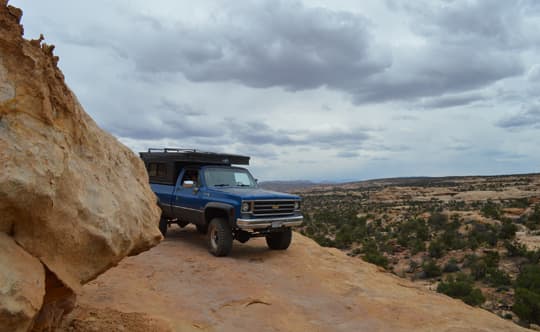
“Two years ago, we used four-wheel drive. We had our Palomino pop-up camper on our truck, which was definitely not overly taxing for the truck. We went to Capitol Reef, Utah. My husband had scoured the area via Google Earth and found the perfect boondocking spot. As we pulled down into the area of narrow, sandy, highly-intersecting roads, we realized the trailer with our Jeep was a bit much for the deepening sand. We knew it was time to get while the getting was good.
We had to leave the truck to scout which of the five or so roads to go down to get back to the highway, and were immediately swarmed by flocks of huge biting flies (yes, flocks is the right term for packs of flies this size!). We ran as fast as the sand would let us down the roads to find the right road out. Then we jumped into the truck to get the heck out of there! Let’s just say, without four-wheel drive to pull us and the 8,500 pounds of Jeep and trailer out of the sand, they would have still likely not found our bodies today!
I won’t tell you that just yesterday we took our new Lance camper for the first time boondocking. We’re still pretty new to this off-the-grid thing. With the UTV and bikes in tow, we went out on a narrow dirt road (marked for RV camping – yeah, right!) and almost got to use four-wheel drive again. It also looked like we were going to tip over at one point, but that’s a different learning experience all together!” – Tracy Schuster, 2012 Chevy Silverado 3500, four-wheel drive truck, 2012 Lance 992
“When we take our quads to the sand dunes we need four-wheel drive to get in and out.” – Bruce Moses, 2006 Chevy 3500, four-wheel drive truck, 2007 Lance 1191
“I have never needed four-wheel drive. You just have to pay a bit more attention to the line you pick. I am sure beach bums need it, but I am a more of a hills and hollers guy. Thanks for the great site. Keep on trucking!” – John Haughey, 1996 Ford F150, two-wheel drive truck, 1993 Shadow Cruiser
“Four-wheel drive versus two-wheel drive was an important consideration before I bought my GMC Sierra in 2001. Because of being a birder, I go off-pavement regularly on gravel, caliche, and sand in places like Texas, Colorado, the West, and now the Northwest.
In practice, I rarely needed four-wheel drive, so I bought two-wheel drive. I decided that if I needed four-wheel drive for something, like going up Cinnamon Pass in Colorado, I would rent a Jeep for the day. I never regretted my decision to buy the 2001 GMC two-wheel drive.
When I bought my Tundra in 2012, I bought another two-wheel drive truck. Not having four-wheel drive makes me avoid tricky areas, and given that I am by myself 75% of the time, I think that is sensible. Having four-wheel drive can make people do foolish things that lead to trouble. I have seen/heard numerous tales of people with four-wheel drive getting themselves stuck in places like the Padre Island, Texas beach.
Some people need four-wheel drive, but I don’t. With two-wheel drive, I saved money up front, and I get better gas mileage. It works for me.” – Lori Markoff, 2012 Toyota Tundra, two-wheel drive truck, sold my Phoenix pop-up last year
“We once camped on the beach at Lake Ogallala, Nebraska and came very close to getting stuck in the sand. A four-wheel drive truck may have been better in that situation. However, 99% of the time, our two-wheel drive truck with a limited slip differential is all we need for the type of traveling and camping we do.” – Buzz Merchlewitz, 1998.5 Dodge Ram 2500, two-wheel drive truck, 2007 Four Wheel Grandby
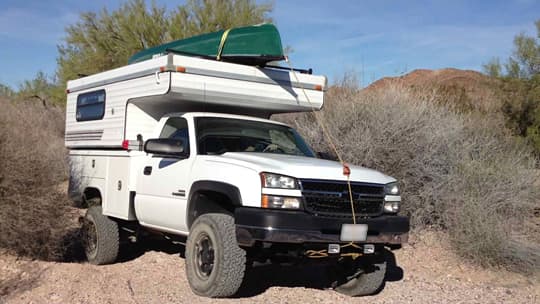
“All of our trucks have been equipped with four-wheel drive. We’ve had to use it many times in our thirty-plus years of pop-up truck camping. It has made a difference in getting out of a jam verses walking miles to get help. We are avid desert campers and many backcountry trails in the West have soft sand to negotiate. Rough, eroded, and rocky roads also present their challenges and the extra ground clearance with the four-wheel drive is another benefit. Add steep inclines where a transfer case with low-range can come in handy and you can see why we include four-wheel drive in our truck and camper requirements. We would never consider heading out in our pop-up camper in anything but a four-wheel drive truck.” – Cliff and Susie Kellogg, 2006 Chevy 2500 HD, four-wheel drive truck, 1999 Apache pop-up
“Recently we got lost on a dirt forest service road on the way to a remote view point on the North Rim of the Grand Canyon. We unwittingly ended up on a 400 yard steep, slanting, rough, rutted and narrow four-wheel drive road to get back to the main forest service road. Four-wheel drive low really helped on the comfort level climbing out, even though I probably could have made it in four-wheel drive high. Several other times I used four-wheel drive low on steep high clearance roads to avoid having to ride the brakes coming down the hill. When winter camping in West Virginia, I routinely go into four-wheel drive high on the snow covered winding country roads. It just adds comfort.” – Dave Kiel, 2007 Toyota Tundra, four-wheel drive truck, 2012 Phoenix Pulse
“I might be banned here for life, but my rig is a twenty-two foot motorhome, on a Ford E350 chassis, with four-wheel drive (a Quigley conversion). I wouldn’t buy a rig without four-wheel drive since we frequently go to Assateague Island, and camp on the beach. I also have camped in grassy campgrounds where I would have been stuck without four-wheel drive. We used to have an Amerigo camper, but we like the walk-through access in the motorhome. There is no wasted space, like there is between the truck bed and the sides of a camper.” – Tom Watson, 1999 Ford E-350, four-wheel drive truck, 1999 Four Winds 22RK
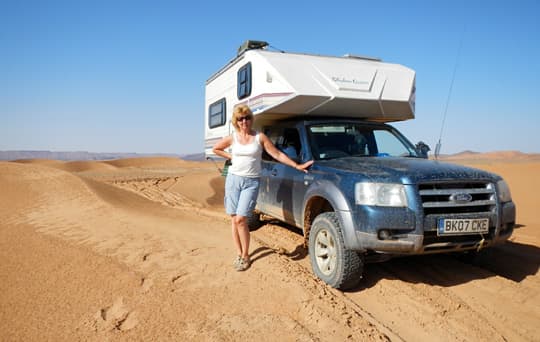
“We were glad to have four-wheel drive when crossing a wadi in the Sahara. But thinking more domestically, it is nice to have the reassurance of four-wheel drive when on a sloping grass campground in the rain.” – Steve Blackman, 2007 Ford Ranger, four-wheel drive truck, 1991 Shadow Cruiser, Sky cruiser 1
“Yes, a couple of times we’ve used four-wheel drive. Once we used it in Alaska going up a super steep and rutted road entering into a beautiful boondocking spot. Backing out was the main issue. We’ve also used it a couple of times in the desert in soft sand arroyos. Having four-wheel drive is a security blanket that allows me to go places that are just that much more risky without it. Sorry, no photos; too busy staying unstuck!” – Maggie, 2011 Dodge Ram, four-wheel drive truck, 2002 Lance 1130
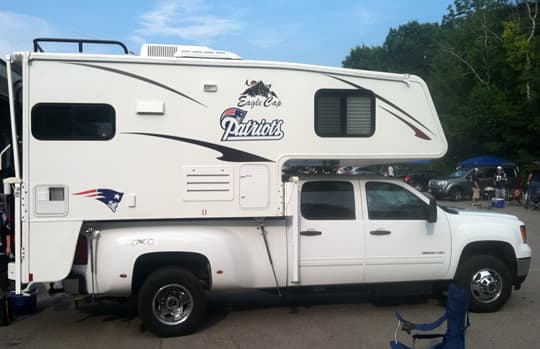
“We use our camper more in the Fall and Winter, since we own a tour boat company on Cape Cod called the Monomoy Island Ferry. We especially use our camper every other weekend in the fall as our Eagle Cap is our Patriot Palace for tailgating with our New England Patriots season tickets, at Foxboro Stadium.
Twice in recent years, we have left the stadium, later in the football season, with a two-hour drive home in a snowstorm. On both trips, the highways were untouched by plows and untreated with salt and sand. Four-wheel drive was key to our making it home safely.
Our 2012 GMC 3500 has both the tow haul and engine brake, which is helpful in using the brakes as little as possible in poor road conditions. So, four-wheel drive is a must for us.” – Keith Lincoln, 2012 GMC 3500 DRW, four-wheel drive truck, 2010 Eagle Cap 855
“I have had both two-wheel and four-wheel drive rigs over the past thirty years. Most operation is in two-wheel drive but, when you want four-wheel drive, you need it or seek help some how. The two-wheel drive rigs were often painfully helpless in a snowy climate like Alberta or in wet off road conditions.
Four-wheel drive is much easier on the tires when going up steep rocky logging roads. Two-wheel drive would do, but the tires have to scratch and dig for traction where a four-wheel drive drive just rolls over stuff because the torque is spread over four points, not just two.
I have considered the cost, weight, and payload question many times. My experience is painfully annoying with two-wheel drive rigs. I only buy four-wheel drive vehicles where I live and like to travel. It’s very rewarding when needed.” – John Hallett, 2011 Dodge 3500, four-wheel drive truck, 2012 Arctic Fox 990
“I have used four-wheel drive occasionally carrying our previous camper, a Sunlite 865, on some real muddy or steep rocky backroads. However, we have used four-wheel drive a lot on excursions to remote areas after we’ve dropped the camper at a campground. We carry two twelve-foot kayaks on our camper. As soon as we arrive at an area with good kayaking waters, we drop the camper, set up camp, and load the kayaks in the truck. We would not be without four-wheel drive.” – Fred Carey, 2014 GMC 3500, four-wheel drive truck, about to purchase a 2013 Eagle Cap 950

“We dry camped on the bank of the Buffalo River. It’s all river rock and pretty slippery stuff, so we need four-wheel drive.” – Rodger Greene, 2004 GMC 2500HD, four-wheel drive truck, 2012 Travel Lite 700
“If I unload our Travel Lite 890, then put boat in water, the Cummins engine is so heavy, there is little weight on the rear wheels. With algae on the ramp, sometimes I have a hard time getting out. If I launch the boat before taking the camper off the truck, I don’t have that trouble. Four-wheel drive is like 4:10 rear end. Sure it comes up the hills, but you pay for it in rpm’s and fuel. I wish I had gotten a 3:73 (or whatever Dodge has). I don’t need the 4:10 as often as I need better mileage.” – Ken Wright, 2005 Dodge 2500D, two-wheel drive truck, 2011 Travel Lite 890
“We may or may not have needed four-wheel drive, but it has come in handy twice. Once while leaving Idaho for our winter snowbird area we hit an early season snowstorm in Northern Nevada. That was in late October. Snow was accumulating on the road so I shifted into four-wheel drive.
One other time we were visiting friends who have a place sixteen miles outside Ely, Nevada on a rough dirt road and a rougher dirt driveway. Four-wheel drive came in handy getting the camper into a level location for camping. I have to admit, though, that we would probably have been fine even without four-wheel drive, but it did provide a certain level of confidence. Having lived in the mountains of Idaho for over forty years, four-wheel drive as always been considered a necessity, but now that we leave Idaho in the winter for a warmer climate, we are seriously considering moving to a two-wheel drive truck to save weight and initial expense, plus an improvement in miles per gallon.” – Dave Neumann, 2010 Toyota Tundra, four-wheel drive truck, 2011 Adventurer 80GS
“I have had to put my truck in four-wheel drive many times, sometimes just for a steep hill at a stop light in the rain. I also use it moving things around the yard when one would hardly think it necessary. However, I do not recall ever shifting when my camper was on. I have not been in a serious off-road situation while truck camping.” – Fred Patterson, 2013 Ford F350 SD, four-wheel drive truck, 1977 Mobile Traveler
“I don’t know if I have ever needed four-wheel drive. I put it into four-wheel drive when I think I might need it. I’ve never got stuck, so maybe I didn’t need it! I use it mostly on dirt roads, never on sand, yet!” – Mike McMahon, 2006 Ford F350, four-wheel drive truck, 1999 Lance 1030
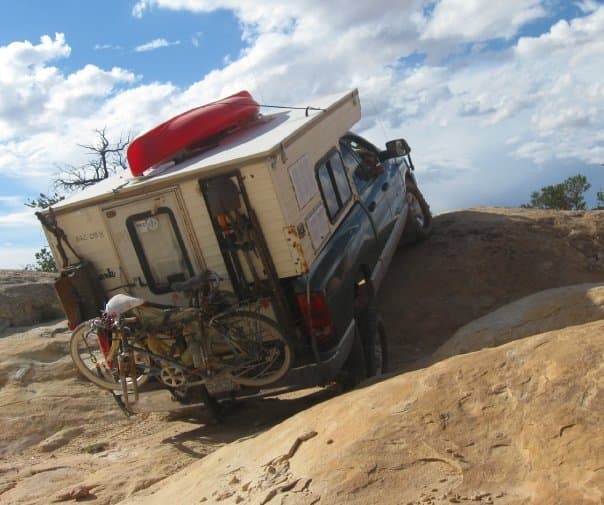
“Well, you guys know me personally, and my lifestyle with my truck camper. I could not live without four-wheel drive. It’s what separates me, what I do and where I go, from the usual truck camper crowd.
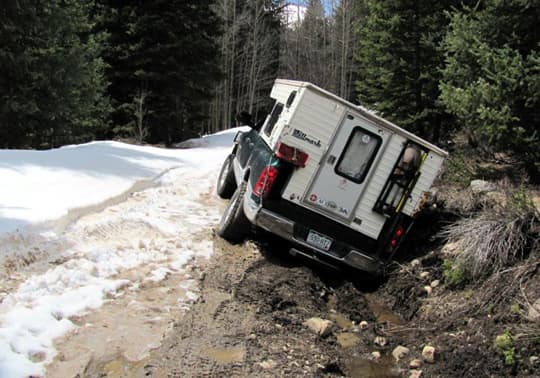
Besides my adventure side to where I go, living in the Rocky Mountains almost demands I have four-wheel drive anyway. It can snow anytime of year in the high country. I recall a mid-July trip years ago west of Boulder when an eighty degree day turned into a twenty degree night with snow. Many trips I plan on using the four-wheel drive. But, once in awhile, unplanned weather, or other situation, and the need to engage the front axle to keep from getting stuck, or unstuck have come to the rescue. For me, four-wheel drive is a must have and worth every extra penny it runs me.” – Jim McCoy, 2003 Dodge Ram 2500, four-wheel drive truck, 1991 Hallmark LaVeta
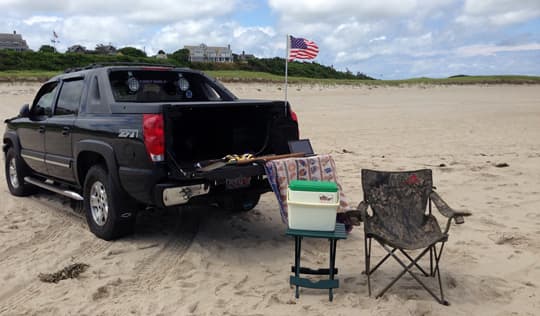
“I camp on the beach and hunt in the backwoods of Maine. I need four-wheel drive.” – Thomas Robbins, 2013 Chevy Avalanche, four-wheel drive truck, bed tent
“We have owned our truck since June of 2010. It was not a question of whether I needed four-wheel drive. I wanted it just in case we are in a situation where we need it. We haven’t done backwoods/desert off-road rock crawling. I respect my truck too much to risk breaking anything.
I realize with the extra weight of four-wheel drive it reduces my payload. So we keep a close watch on items we bring along. I do use four-wheel drive to go up and down boat ramps when launching the sailboat, which gives me peace of mind.
A couple of years back we were heading south on I-5 in late March and had to cross the Siskiyous. A morning snowstorm had Cal-Trans making chains required for the drive past Mt. Shasta. We passed hundreds of cars on the side of the road either chaining up or waiting to cross when the freeway would reopen. We did not have chains but, with mud and snow tires and in four-wheel drive high, we were permitted to continue at a snail pace of twenty to twenty-five miles per hour. Yes, we’re glad we have four-wheel drive.” – Roger and Elaine Odahl, 2008 Dodge Ram 3500, four-wheel drive truck, 2004 Eagle Cap 950
“We needed four-wheel drive when we took a trip around many parts of the country back in 2012. We had just visited the Grand Canyon and were on our way to our campground in Utah for our next night. We put the address in our GPS not checking the route it would take us on because it had done well so far on our trip. I had always checked the route prior to this day but didn’t this time. We were traveling on a state road that turned to a wide gravel road that was well maintained, so we kept going.
Then the road got narrower and narrower and we were about ten miles to our destination when we got to a sign that said sharp curves and steep grades not passible when wet. I looked at the fuel gauge and realized we didn’t have enough fuel to turn around. So we traveled on putting the truck in four-wheel drive low to help with the steep grades as we drove in and out of canyons and drove through seven river beds.
Two hours later, we were back on pavement and so glad we had four-wheel drive. I will always have a four-wheel drive truck and truck camper to continue exploring this great country.” – Brad Rau, 2009 Ford F350, four-wheel drive truck, 2007 Arctic Fox 990
“I off-road camp a lot. One instance in particular answers this question the best. Two years ago while elk hunting in the Colorado Rockies it started snowing a fair amount on our second day out. We weren’t having much luck in the area, so we decided to move to a new location. With two feet of snow on the ground we broke camp and traveled northeast up and over the continental divide, all on gravel back roads. I spent most of that day in four-wheel drive low as I had an off-road trailer as well as my camper on the Bronco. I’m also happy to say my Bronco has lockers in both axles, which were absolutely required to pull up the final narrow trail to our campsite. So far, this is the most I’ve ever asked of my rig while camping and hunting. It didn’t let me down.” – Kirk Inderbitzen, 1973 Ford Bronco, four-wheel drive truck, 1970’s Four Wheel pop-up
“I live in Idaho and most of our camping is boondocking. I’ve used four-wheel drive on some very steep, 8% to 12%, rough downhill grades. My truck is an automatic. In two-wheel drive high, first gear, I was having to use too much brake and the wheels would lock up. Using four-wheel drive low range I was able to idle down the hill.
In the Spring, when the snow is melting, it’s better to use four-wheel drive in the soft slick stuff especially when towing rather than trying it in two-wheel drive only to find you should have put it into four-wheel drive out in the middle of the mess.” – Dave Erickson, 2011 Ford F350, four-wheel drive truck, 2006 Arctic Fox 990
“I’ve owned two older truck campers. I had a hard side and a pop-up. Both were hauled with my 1996 Ford F250 4×4. I needed four-wheel drive when camping at the Texas Motor Speedway years ago. It rained while I was there for a week and the four-wheel drive was very helpful. You never know when you’ll need it and I’m glad I did.
I now own a Timberlodge pull behind camper that I like a lot, but am looking at getting another truck camper. I enjoyed carrying my second home around with me. My trucks will always be four-wheel drive, too!” – Linda Lancaster, 1996 Ford F250, four-wheel drive truck, one hard side fully loaded, and a pop-up slide-in
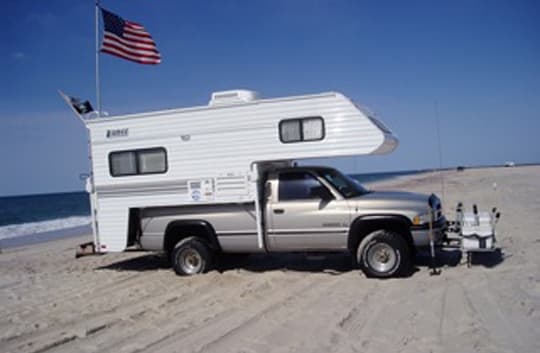
“I use my rig to fish the Long Island Beaches most weekends. Four-wheel drive is a must on the beach. Airing down and four-wheel drive is the way to go. I also use my rig to camp in upstate New York. Going up dirt roads in low range is another advantage. Slow and steady. I am able to use my rig more due to four-wheel drive.” – Paul LaMonte, 1999 Dodge Ram, four-wheel drive truck, 2005 Lance 1025
“Our main reason for purchasing a truck camper was to access the remote washes of the desert and for camping and traveling in the winter time. I used four-wheel drive with our Northstar Laredo, Eagle Cap 800, and with our Wolf Creek 850.” – Nolan Sturgeon, 2001 Ford F350, four-wheel drive truck, 2014 Wolf Creek 850
“I have used four wheel drive many times when driving conditions are snowy and slick in the fall and winter while hunting in eastern Washington. I have had all tires chained up when conditions require it. We also use our pickup truck and camper to winter camp and cross country ski. We enjoy the option of four wheel drive when needed.” – Leonard Eagle, Jr., 2009 Ford F450, four-wheel drive truck, 2008 Okanagan TKS126
“When we travel in Baja we are a lot more relaxed with a four-wheel drive truck, a 12,000 pound winch, thirty gallons of extra fuel, and our tools. And watch out for dry lake beds!” – Phil Rodgers, 2000 Ford F450, four-wheel drive truck, 2003 Lance 1130
“As far as I’m concerned, a truck is not a truck if it doesn’t have four-wheel drive. Why would I invest all this money into my multipurpose vehicle only to say, “Gee, there are some places I can’t go because I don’t have four-wheel drive. Now I realize a dually can’t go everywhere, but where I go, I don’t want to be limited. Since I’ve had my rig I have used four-wheel drive twice. Once was in the sand at the lake while enroute to a campsite. Another time was while I was retrieving my boat on a slippery boat launch. I’m sure glad I had four-wheel drive!” – Dr. Dee, 2008 Ford F-350, four-wheel drive truck, 2008 Lance 1191
“On several occasions while attending our church camp here in Alaska I have used four-wheel drive. We are seven and a half miles off the Parks Highway at Lynx Lake. It is needed about every other year depending on the weather. We try to keep the roads up, but there are several places where there are mud holes (not puddles) that are slick and sometimes are at least of foot and sometimes deeper. It never has stopped us though from enjoying the experience. It has only made it better.” – Darrell, 2012 Dodge Ram 2500HD, four-wheel drive truck, 2007 Lance 815
“I need four-wheel drive to cross I-80 over Donner Pass in January and February. I also use it on any muddy road that makes the rear tires spin. We camp fall to early spring, and not summer.” – Mike Kolinski, 2012 GMC Sierra 2500HD, four-wheel drive truck, 2012 Four Wheel Hawk
To return to The Four-Wheel Drive Low Down: Part 1, click here.
